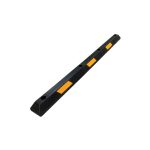Definition and Types
Parking bumpers blocks, also known as wheel stops or parking blocks, are physical barriers used in parking lots to prevent vehicles from rolling beyond a designated parking area. They serve as a guide for drivers to position their vehicles within a parking space and protect surrounding infrastructure, such as sidewalks, landscaping, and other parked cars.
Parking bumpers come in various types, each suited for different parking environments:
- Concrete Bumpers: Heavy and durable, ideal for long-term use in commercial settings.
- Rubber Bumpers: Flexible and less damaging to vehicles, commonly used in residential and light commercial areas.
- Plastic Bumpers: Lightweight and often made from recycled materials, suitable for temporary or seasonal applications.
- Metal Bumpers: Strong and resistant to weather, used in industrial settings where heavy vehicles are common.
The choice of parking bumper type depends on factors such as the expected traffic volume, vehicle types, and environmental conditions. Selecting the appropriate type ensures the safety and longevity of the parking facility.
Materials Used in Construction
Parking bumpers, also known as wheel stops or parking blocks, are typically constructed from a variety of materials, each offering distinct benefits and characteristics. Concrete is one of the most common materials due to its durability and strength. Rubber, often recycled from tires, is another popular choice, known for its shock absorption and lighter weight.
- Concrete: Durable, heavy, weather-resistant
- Rubber: Lightweight, shock-absorbing, made from recycled materials
- Plastic: Low maintenance, resistant to weather and chemicals
- Steel: Strong, long-lasting, but prone to rust without proper treatment
The selection of material for parking bumpers significantly influences their longevity and performance. It is crucial to consider the specific needs of a parking lot, such as climate, traffic volume, and budget, when choosing the appropriate material.
Installation Process
The installation of parking bumpers is a straightforward process that typically involves positioning, leveling, and securing the bumpers to the pavement. Proper installation is crucial to ensure they perform their intended function effectively.
- Positioning: Place the bumpers where vehicles are intended to stop.
- Leveling: Adjust the bumpers to lie flat against the surface to prevent tripping hazards or vehicle damage.
- Securing: Use appropriate hardware to anchor the bumpers firmly to the ground.
It’s important to follow the manufacturer’s guidelines and local regulations to ensure the parking bumpers are installed correctly and safely. Improper installation can lead to increased wear and tear, and may even pose safety risks.
Functional Advantages of Parking Bumpers
Vehicle Safety and Protection
Parking bumpers play a crucial role in enhancing vehicle safety and protection in parking lots. They prevent cars from rolling beyond the parking space, which can lead to collisions with other parked vehicles or with pedestrians. This simple measure significantly reduces the risk of parking-related accidents.
- Prevents vehicles from overrunning the parking space
- Reduces the likelihood of fender benders
- Protects vehicles from encroaching into pedestrian areas
Parking bumpers from https://unimat-traffic.com/ serve as a physical reminder for drivers to slow down and park carefully, contributing to a safer parking environment for everyone.
The strategic placement of parking bumpers can also guide drivers into parking spaces more accurately, ensuring that vehicles are parked in an orderly fashion. This not only protects the vehicles but also maintains clear pathways for emergency access.
Pedestrian Safety
Parking bumpers play a crucial role in enhancing pedestrian safety in parking lots. They act as a physical barrier, preventing vehicles from encroaching onto sidewalks and pedestrian zones. This separation minimizes the risk of accidents, especially in high-traffic areas where drivers and pedestrians are in close proximity.
- Clearly demarcate walking areas
- Reduce the likelihood of vehicles overrunning curbs
- Provide visual cues to drivers to maintain safe speeds
Parking bumpers contribute to a safer environment for pedestrians, offering peace of mind and reducing the potential for vehicle-pedestrian collisions.
The strategic placement of parking bumpers can guide foot traffic, leading to a more organized and secure parking lot. Their presence is a reminder for drivers to be vigilant and cautious, especially when reversing or maneuvering in tight spaces.
Maximizing Parking Space Efficiency
Parking bumpers play a crucial role in maximizing the efficiency of parking spaces. By clearly delineating parking spots, they help drivers align their vehicles more accurately, ensuring that each car occupies only the designated space. This precision prevents inefficient use of the parking area and allows for the accommodation of more vehicles.
- Ensure proper vehicle alignment
- Prevent cars from overhanging onto sidewalks or landscaping
- Allow for more cars in a given area
Efficient parking leads to a smoother flow of traffic within the lot, reducing congestion and the potential for accidents.
The strategic placement of parking bumpers can also guide drivers towards the most efficient use of the parking lot, directing traffic in a way that minimizes the time spent searching for a spot. This not only saves time for the drivers but also reduces emissions from idling vehicles.
Aesthetic and Environmental Benefits
Enhancing Parking Lot Appearance
Parking bumpers can play a significant role in improving the overall aesthetics of a parking lot. Well-designed parking bumpers contribute to a neat and organized appearance, which can be particularly important for businesses looking to make a good first impression.
- Color Coordination: Parking bumpers can be painted or constructed in colors that complement the surrounding environment or the branding of a nearby business.
- Uniformity: Consistent use of parking bumpers throughout a parking area creates a uniform look that is visually appealing.
- Custom Designs: Some parking bumpers come with the option for custom designs or patterns, adding a unique touch to the parking lot.
The strategic placement of parking bumpers not only serves a functional purpose but also enhances the visual harmony of the space, making it more inviting to users.
Eco-Friendly Options
In the realm of parking bumpers, eco-friendly options are gaining traction as a means to reduce environmental impact. Recycled materials are now commonly used in the production of parking bumpers, offering a sustainable alternative to traditional concrete or plastic models.
- Recycled rubber from tires
- Recycled plastic
- Composite materials
These materials not only divert waste from landfills but also require less energy to produce, making them a greener choice for parking lot installations. Moreover, eco-friendly parking bumpers often come in a variety of colors and finishes, allowing for aesthetic customization while maintaining environmental responsibility.
By choosing eco-friendly parking bumpers, property owners can contribute to a circular economy, where products are reused and recycled, minimizing the depletion of natural resources.
Durability and Maintenance
Parking bumpers are designed to withstand various environmental conditions, making them a long-lasting component of any parking lot. Durability is a key factor in their appeal, as they require minimal maintenance over time. This resilience translates to fewer replacements and repairs, ensuring cost savings for property owners.
- Regular inspection for wear and tear
- Simple cleaning with water and mild detergents
- Immediate repair or replacement of damaged units to maintain functionality
The ease of maintenance for parking bumpers not only preserves their appearance but also ensures they continue to perform their intended safety functions effectively. With proper care, these parking lot essentials can serve their purpose for many years, contributing to a well-maintained parking environment.
Economic Implications of Using Parking Bumpers
Cost-Effectiveness
Parking bumpers offer a cost-effective solution for managing parking lots. Their initial investment is relatively low compared to the protection they provide against potential vehicle damage and the costs associated with repainting parking lot lines.
- Lower installation costs: Compared to other parking control methods, parking bumpers are less expensive to install.
- Minimal maintenance: Once installed, they require little to no maintenance, saving on long-term upkeep costs.
- Reduction in accidents: By preventing cars from overrunning parking spaces, they reduce the likelihood of accidents and the associated financial implications.
The strategic placement of parking bumpers can lead to a more organized parking lot, which not only improves the flow of traffic but also minimizes the risk of collisions and the subsequent expenses for repairs and insurance claims.
Long-Term Savings
Investing in high-quality parking bumpers can lead to significant long-term savings for property owners. The durability of these installations means reduced frequency of replacements and maintenance costs. Over time, the initial investment is offset by the longevity and minimal upkeep required.
- Reduced replacement costs
- Lower maintenance expenses
- Less frequent need for repairs
The use of parking bumpers also contributes to a safer parking environment, potentially decreasing the likelihood of accidents and the associated financial repercussions. This preventative measure can be a wise financial decision, safeguarding against costly liabilities.
Impact on Property Value
The presence of parking bumpers can have a positive impact on the property value of a commercial space. Well-maintained parking facilities with clear demarcations and safety features are attractive to potential buyers and tenants, signaling a property that is cared for and secure.
- Enhanced Curb Appeal: Parking bumpers contribute to the overall aesthetics of a parking lot, which can influence first impressions.
- Reduced Liability: With parking bumpers in place, the likelihood of parking-related accidents decreases, potentially lowering insurance premiums and increasing the property’s desirability.
- Perceived Value: A parking lot equipped with safety features such as parking bumpers can lead to a perception of higher quality and better maintenance.
The strategic placement of parking bumpers not only serves a functional purpose but also acts as an investment in the property’s future value. By improving safety and organization, parking bumpers can make a property more appealing to prospective buyers or renters, ultimately affecting its market value.
Legal and Compliance Aspects
Regulatory Standards
Parking bumpers, often integral to parking lot design, must adhere to various regulatory standards to ensure safety and accessibility. Compliance with these standards is not only a legal requirement but also a measure to prevent accidents and lawsuits.
- The Americans with Disabilities Act (ADA) sets forth specific guidelines for parking bumpers to accommodate individuals with disabilities.
- Local building codes may dictate the size, placement, and number of parking bumpers required in a parking lot.
- International building codes also influence the standards for parking bumpers, ensuring consistency in safety measures globally.
It is crucial for property owners and managers to stay informed about the latest regulations to avoid penalties and to ensure the parking lot is accessible and safe for all users.
Accessibility Requirements
Ensuring that parking facilities are accessible to all individuals, including those with disabilities, is not just a matter of convenience but a legal mandate in many jurisdictions. Parking bumpers must be positioned and designed to accommodate the needs of disabled persons, providing clear access paths and adhering to specific height and spacing regulations.
- Compliance with the Americans with Disabilities Act (ADA) Standards for Accessible Design
- Adequate space next to bumpers for wheelchair transfer
- Visible and tactile warnings for visually impaired individuals
It is essential for parking lot owners to regularly review and update their facilities to meet the latest accessibility standards, as failure to comply can result in significant fines and legal action.
The design and placement of parking bumpers play a crucial role in creating an inclusive environment. By following the established guidelines, parking lots can ensure that they are accessible to everyone, thereby enhancing the overall user experience and promoting equality.
Liability and Insurance Considerations
The use of parking bumpers can significantly influence liability and insurance considerations for property owners. Proper installation and maintenance of parking bumpers are crucial to minimize the risk of accidents and potential lawsuits.
- Compliance with local regulations ensures that parking bumpers meet safety standards, reducing liability.
- Insurance companies may offer lower premiums to properties that demonstrate a commitment to safety through the use of parking bumpers.
The presence of parking bumpers can be a factor in legal disputes following parking lot incidents. Their absence or poor condition could imply negligence, affecting the outcome of such cases.
Owners should consult with their insurance providers to understand how parking bumpers might affect their coverage and to ensure that they are adequately protected against claims.
Conclusion
In summary, parking bumpers serve as an essential tool in managing parking spaces efficiently and safely. Their advantages extend beyond mere organization, offering protection to vehicles, pedestrians, and property alike. The benefits of using parking bumpers include reduced risk of parking-related accidents, enhanced visual cues for drivers, and the maintenance of order in parking areas. By implementing these simple yet effective devices, parking lot operators can ensure a higher level of safety and convenience for all users. Ultimately, parking bumpers are a cost-effective investment that pays dividends in the form of a more structured, secure, and user-friendly parking environment.
Frequently Asked Questions
What exactly are parking bumpers and what are their common types?
Parking bumpers, also known as wheel stops or parking blocks, are physical barriers used in parking lots to prevent vehicles from overrunning the parking space. Common types include concrete, rubber, and plastic bumpers, each with different characteristics and uses.
What materials are typically used to construct parking bumpers?
Parking bumpers are constructed from a variety of materials including concrete, rubber, recycled plastic, and polyethylene. Each material offers different benefits in terms of durability, weight, and environmental impact.
How are parking bumpers installed?
Installation of parking bumpers typically involves measuring and marking the correct positions, preparing the surface, and securing the bumpers using concrete anchors, adhesive, or spikes, depending on the type of bumper and the surface it’s being attached to.
What are the main advantages of using parking bumpers?
The main advantages of using parking bumpers include increased vehicle and pedestrian safety, prevention of property damage, and more efficient use of parking space. They also help in organizing traffic flow within parking lots.
How do parking bumpers contribute to the aesthetics of a parking lot?
Parking bumpers can enhance the appearance of a parking lot by providing a neat, organized look. They can be painted or designed to match the surrounding environment, and when made from eco-friendly materials, they contribute to a green image.
What economic benefits do parking bumpers offer?
Economic benefits of parking bumpers include cost-effectiveness due to their low maintenance needs, potential long-term savings from reduced property damage, and a possible increase in property value due to improved safety and appearance.
| https://bestcitytrips.com/road-safety-speed-bumps-for-sale-near-me/ |
| https://mallumusic.info/now-you-can-have-parking-block-for-road-safety/ |







